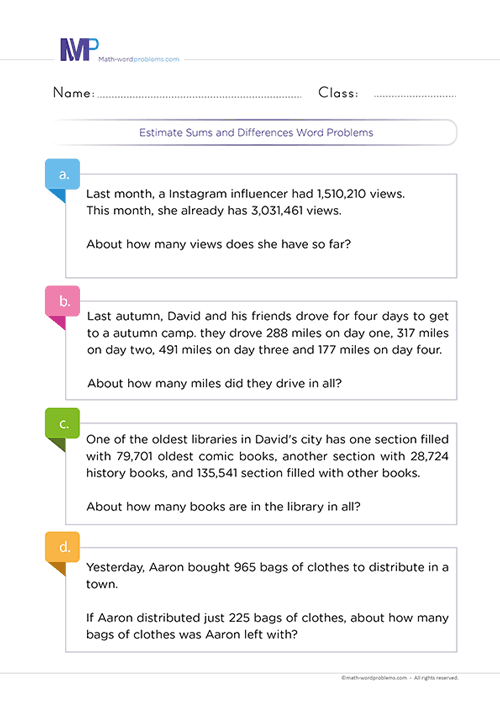 Estimating comparing ordering rounding worksheets 5th Grade
Estimating comparing ordering rounding worksheets 5th Grade

- INTRODUCTION
- Download worksheets
- Related Contents
- What is the general rule for estimating comparing ordering r...
Get more contents on Estimating Comparing Ordering Rounding Word Problems...
Build your kid's number sense and problem-solving skills by encouraging them to practice our estimating comparing ordering rounding worksheets 5th Grade. These skills are used quite often in math and our daily lives. Below are some short definitions of estimating, comparing ordering, and rounding.
- We use estimation when finding an approximate answer or when accuracy is unnecessary. For instance, you may want to quickly guess how much you will spend preparing for your upcoming birthday party, considering the number of people that will be available.
- We compare numbers or objects to find out which one is bigger or smaller than the other. For instance, you can use estimation skills to check if your answer makes sense or if you have enough money to buy something you so desire.
- On the other hand, ordering is arranging numbers from least to greatest or vice versa.
- And rounding is a way of making a number simpler while its value remains close to what it was. We can round numbers to the nearest multiple of 10, 100, 1000, etc. For instance, imagine reading or working with numbers such as 1,879 and 146. You'll bear with me that they seem slightly complicated compared to having rounded them to 2,000 and 1500. Besides, this skill will help you plan your budget faster and more accurately.
All the above skills are fundamental in math and many areas in our daily lives. Hence, we will provide stimulating worksheets for kids to practice estimating, comparing, rounding, and ordering numbers, sums, differences, products, and quotients. In math and our daily lives, you'll realize that we often use estimation, especially to check the reasonableness of an answer or make calculations easy. This mental way of doing calculations (estimation) will become easy if you can efficiently round, order, and compare numbers.
Estimating sums, differences, products, and quotients worksheets Grade 5
Estimating sums, differences, products, and quotients worksheets Grade 5 consist of fun engaging exercises, real-life problems, and strategies for quickly estimating sums, differences, products, and quotients. Even though there are different methods and strategies for estimating different operations, rounding is the most common. We must recall that rounding replaces a number with another of approximately the same value. However, estimating comparing ordering rounding worksheets 5th Grade will design each worksheet for each operation with its rounding method so that your 5th graders can practice and acquire each skill before moving on to the next.
How do we estimate sums, differences, products, or quotients? When estimating sums, differences, products, or quotients, we round addends, minuend/subtrahend, factors, and dividend/divisor before finding the sum, difference, products, or quotients. In the case of two-digit numbers, we round the number to the nearest tens place. For three-digit numbers, we can round them to the nearest hundred place. In the case of four-digit numbers, we can round them to the nearest thousands place. Let's take a look at a few examples below:
- If we want to estimate 59 + 36, we round both numbers to the nearest 10 and get 60 + 40 = 130.
- To estimate 241 – 28, we'll round the minuend to the nearest 100 and the subtrahend to the nearest 10. Thus, we will have 140 – 30 = 110
What is the general rule for estimating comparing ordering rounding worksheets 5th Grade?
What is the general rule for estimating comparing ordering rounding worksheets 5th Grade? Engage and have fun in this resource while learning the general rule for estimating, comparing, ordering, and rounding numbers. As earlier said, the general rule for estimation is rounding numbers to the same place value before adding, subtracting, multiplying, or dividing them.
With comparing numbers, the general rule is to align the numbers by their place values and then compare each digit, starting with the greatest place values or from left to right. If one digit is greater than the other, then that number is larger than the other. If the digits are the same, move on to the next digit. Keep comparing digits with the same place value until you find a difference.
Ordering is arranging numbers from smallest to largest or from largest to smallest. With mastery of comparing numbers skills, it will be easy to determine which number is greater and which is smaller. However, your ordering of these numbers will depend on how it was requested, i.e., in ascending order (from smallest to largest) or descending order (from largest to smallest).
Above all, rounding is a way of finding a number close to another number but easier to work with. When rounding numbers, look at the digit in the place value you want to round to and see if it is followed by 5, less than, or more than 5. Suppose it is followed by 5 or more; round that number up. For example, 38 rounded up will become 40. On the contrary, suppose the number you are rounding is followed by a number less than 5; round the number down. For example, 64 rounded down will become 60.








